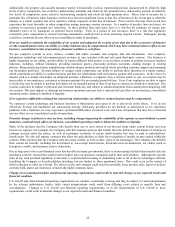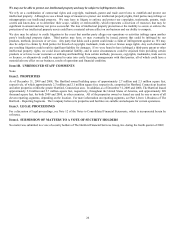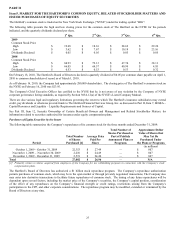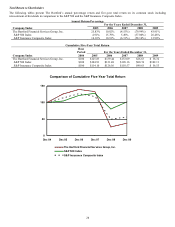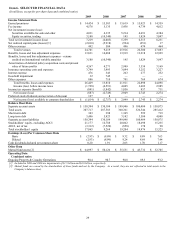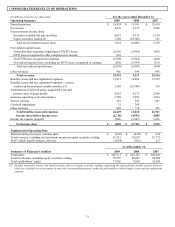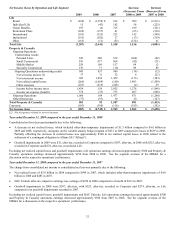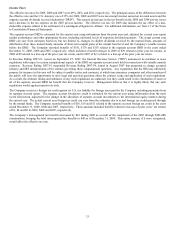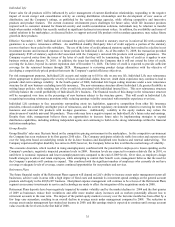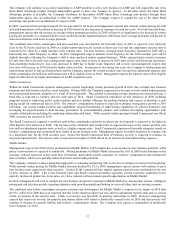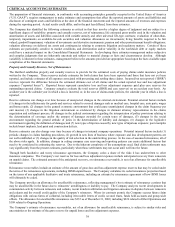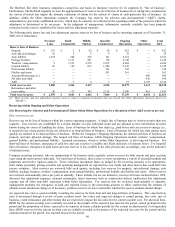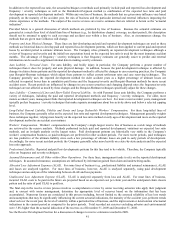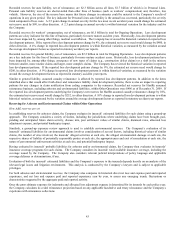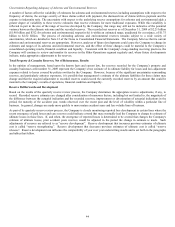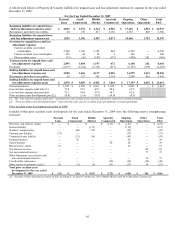The Hartford 2009 Annual Report Download - page 35
Download and view the complete annual report
Please find page 35 of the 2009 The Hartford annual report below. You can navigate through the pages in the report by either clicking on the pages listed below, or by using the keyword search tool below to find specific information within the annual report. 35
Individual Life
Future sales for all products will be influenced by active management of current distribution relationships, responding to the negative
impact of recent merger and consolidation activity on existing distribution relationships and the development of new sources of
distribution, and the Company’ s ratings, as published by the various ratings agencies, while offering competitive and innovative
products and product features. The current economic environment poses challenges for future sales; while life insurance products
respond well to consumer demand for financial security and wealth accumulation solutions, individuals may be reluctant to transfer
funds when market volatility has recently resulted in significant declines in investment values. In addition, the availability and terms of
capital solutions in the marketplace, as discussed below, to support universal life products with secondary guarantees, may reduce future
growth in these products.
Effective November 1, 2007, Individual Life reinsured the policy liability related to statutory reserves in universal life with secondary
guarantees to a captive reinsurance affiliate. An unaffiliated standby third-party letter of credit supports a portion of the statutory
reserves that have been ceded to this subsidiary. The use of the letter of credit enhanced statutory capital but resulted in a decline in net
investment income and increased expenses in future periods for Individual Life. As of December 31, 2009, the transaction provided
approximately $585 of statutory capital relief associated with the Company’ s universal life products with secondary guarantees. The
Company received notice from the issuer of the letter of credit that they will be terminating the letter of credit as it applies to new
business written after January 31, 2010. In addition, the issuer has notified the Company that it will not extend the letter of credit,
covering the in-force, beyond its current expiration date of December 31, 2028. The letter of credit is expected to provide sufficient
coverage for the reinsured business through 2028. Management is reviewing product design alternatives with the objective of
developing a competitively priced product that meets the Company’ s capital efficiency objectives.
For risk management purposes, Individual Life accepts and retains up to $10 in risk on any one life. Individual Life uses reinsurance
where appropriate to protect against the severity of losses on individual claims; however, death claim experience may continue to lead to
periodic short-term earnings volatility. In the fourth quarter of 2008, Individual Life began ceding insurance under a new reinsurance
structure for all new business excluding term life insurance. The new reinsurance structure allows Individual Life greater flexibility in
writing larger policies, while retaining less of the overall risk associated with individual insured lives. This new reinsurance structure
will help balance the overall profitability of Individual Life’ s business. The financial results of this change in the reinsurance structure
will be recognized over time as the percentage of new business subject to the structure grows. This will result in Individual Life
recognizing increasing reinsurance premiums while reducing earnings volatility associated with mortality experience over time.
Individual Life continues to face uncertainty surrounding estate tax legislation, aggressive competition from other life insurance
providers, reduced availability and higher price of reinsurance, and the current regulatory environment related to reserving for term life
insurance and universal life products with no-lapse guarantees. Additionally, volatility in the equity markets may reduce the
attractiveness of variable universal life products. These risks may have a negative impact on Individual Life’ s future sales and earnings.
Despite these risks, management believes there are opportunities to increase future sales by implementing strategies to expand
distribution capabilities, including utilizing independent agents and continuing to build on the strong relationships within the financial
institution marketplace.
Group Benefits
Group Benefits’ sales may fluctuate based on the competitive pricing environment in the marketplace. In this competitive environment
the Company has seen weakness in its first quarter 2010 sales. The Company anticipates relatively stable loss ratios and expense ratios
over the long-term based on underlying trends in the in-force business and disciplined new business and renewal underwriting. The
Company experienced higher disability loss ratios in 2009; however, the Company believes this is within the normal range of volatility.
The economic downturn, which resulted in rising unemployment, combined with the potential for employees to lessen spending on the
Company’ s products, negatively impacted premium levels in 2009. Premium levels are expected to remain relatively flat in 2010, or
until there is economic expansion and lower unemployment rates compared to the end of 2009 levels. Over time, as employers design
benefit strategies to attract and retain employees, while attempting to control their benefit costs, management believes that the need for
the Company’ s products will continue to expand. This combined with the significant number of employees who currently do not have
coverage or adequate levels of coverage, creates continued opportunities for our products and services.
Retirement Plans
The future financial results of the Retirement Plans segment will depend on Life’ s ability to increase assets under management across all
businesses, achieve scale in areas with a high degree of fixed costs and maintain its investment spread earnings on the general account
products sold largely in the 403(b)/457 business. Disciplined expense management will continue to be a focus of the Retirement Plans
segment as necessary investments in service and technology are made to effect the integration of the acquisitions made in 2008.
Retirement Plans deposits have been negatively impacted by market volatility and by the market declines in 2008 and the first quarter
of 2009 as businesses reduce their workforces and offer more modest salary increases and as workers potentially allocate less to
retirement accounts in the near term. The impact of the partial equity markets recovery over the last nine months has been offset by a
few large case surrenders, resulting in an overall decline in average assets under management compared to 2008. The reduction in
average assets under management has strained net income in 2009, and this earnings strain is expected to continue until average account
value exceeds the level seen in the first half of 2008.


